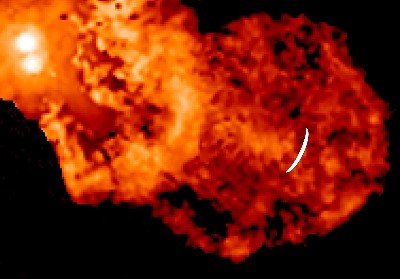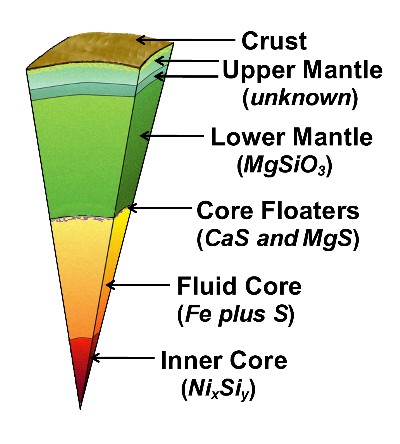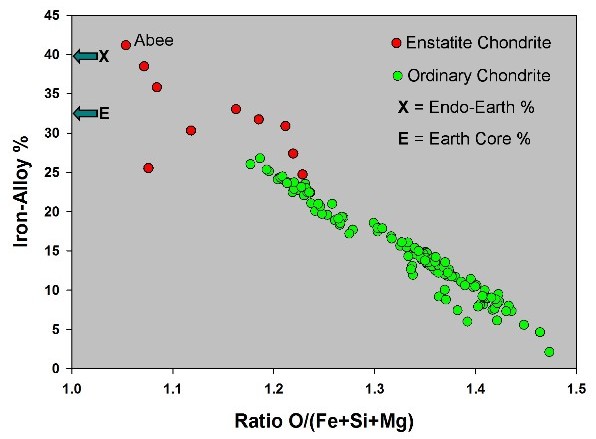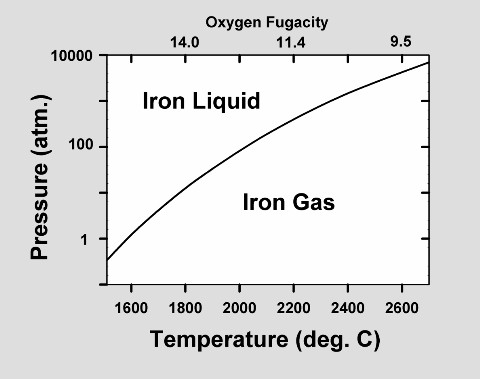 
J. Marvin Herndon's Nature of Planetary Matter |
|
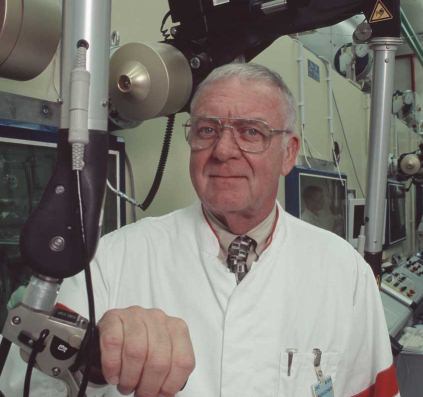 J. Marvin Herndon, pictured at left, has discovered that only three processes, operant during the formation of the Solar System, are responsible for the diversity of matter in the Solar System and are directly responsible for planetary internal-structures, including planetocentric nuclear fission reactors, and for dynamical processes, including and especially, geodynamics. These processes are: (i) Low-pressure, low-temperature condensation from solar matter in the remote reaches of the Solar System or in the interstellar medium, which leads to oxygen-rich condensates; (ii) High-pressure, high-temperature condensation from solar matter associated with planetary-formation by raining out from the interiors of giant-gaseous protoplanets, which leads to oxygen-starved planetary interiors, and; (iii) Stripping of the primordial volatile components from the inner portion of the Solar System by super-intense solar wind associated with T-Tauri phase mass-ejections, presumably during the thermonuclear ignition of the Sun [1]. The constancy in isotopic compositions of most of the elements of the Earth, the Moon, and the meteorites indicates formation from primordial matter of common origin. Primordial elemental composition is yet evident to a great extent in the photosphere of the Sun and, for the less volatile, rock-forming elements, in chondrite meteorites. There is, however, a fundamental degree of complexity which has posed an impediment to understanding for more than half a century: Instead of just one type of chondrite there are three, with each type characterized by its own strikingly unique state of oxidation. Understanding the nature of the processes that yielded those three distinct types of matter from one common progenitor forms the basis for understanding much about planetary formation, their compositions, and the processes they manifest, including and especially magnetic field production.
Much confusion has arisen from decades of making computational models based upon the erroneous assumptions that the mineral assemblage characteristic of ordinary chondrites formed in equilibrium in an atmosphere of solar composition at very low pressures, ca. 10-4 bars, and that ordinary-chondrite-like matter comprises planetary interiors. Herndon and Suess [3] have shown that ordinary chondrite formation necessitates, not an atmosphere of solar composition, but instead an atmosphere depleted in hydrogen by a factor of about 1000. Subsequently, Herndon [4] showed the impossibility of ordinary chondrite-matter being in equilibrium with a gas of solar composition, and showed as well the necessity of some oxygen depletion relative to solar matter. Moreover, the ordinary chondrites appear, not primary, but rather as a secondary mixture, leaving only two types of primary matter, the oxygen-rich carbonaceous chondrite-type matter and the oxygen-starved enstatite chondrite-type matter [2].
In the 1940s and 1950s, the idea was generally discussed about planets “raining out” from inside of giant gaseous protoplanets with hydrogen gas pressures on the order of 102-103 bars [11-14]. But, in the early 1960s, scientists instead began thinking of primordial matter, not forming dense protoplanets, but rather spread out into a very low-density “solar nebula” with hydrogen gas pressures on the order of 10-4 to 10-5 bars. The idea of low-density planetary formation, often referred to as the “standard model”, envisioned that dust would condense at fairly low temperatures, and then would gather into progressively larger grains, and become rocks, then planetesimals, and ultimately planets [28, 29]. These two ideas about planetary formation embody fundamentally different condensation processes which are the underlying cause for the two unique primary types of chondritic matter. The immediate implication is that both processes were operant during the formation of the Solar System. The relative extent and region of each process can be ascertained to some certitude from thermodynamic considerations together with planetary data. Even within present limitations, a consistent picture emerges that is quite unlike the so-called “standard model of solar system formation” [1]. From thermodynamic considerations it is possible to make some generalizations related to the condensation process in an atmosphere of solar composition. At the foundation, there are two dominant considerations, one essentially independent of pressure and one a strong function of pressure, which together are responsible for formation of the two primary types of Solar System matter. In an atmosphere of solar composition, oxygen fugacity is dominated by the gas-phase reaction H2 + ˝O2 = H2O which is a function of temperature, but is essentially independent of pressure over a wide range of pressures where ideal gas behavior is approached. Oxygen fugacity controls the condensate state of oxidation at a particular temperature. At high temperatures the state of oxidation is extremely reducing, while at low temperatures it is quite oxidizing. The state of oxidation of the condensate ultimately becomes fixed at the temperature at which reaction with the gas phase ceases and/or equilibrium is frozen-in by the separation of gases from the condensate. Condensation of an element or compound is expected to occur when its partial pressure in the gas becomes greater than its vapor pressure. Generally, at high pressures in solar matter, condensation is expected to commence at high temperatures, while at low pressures, such as 10-4 to 10-5 bar, condensation is expected to progress at relatively low temperatures at a fairly oxidizing range of oxygen fugacity. At low temperatures, all of the major elements in the condensate may be expected to be oxidized because of the great abundance of oxygen in solar matter relative to the other major condensable elements [30]. Beyond these generalizations, in this low-pressure regime, precise theoretical predictions of specific condensate compounds may be limited by kinetic nucleation dynamics and by gas-grain temperature differences arising because of the different mechanisms by which gases and condensate lose heat. Among the thousands of known chondrites, only a few, like the famous Orgueil carbonaceous chondrite, have a state of oxidation and mineral components with characteristics similar to those expected as a condensate from solar matter at low pressures. Essentially all of the major elements in these few chondrites are oxidized, including sulfur. The idea of planetary formation from a diffuse solar nebula, with hydrogen pressures on the order of 10-4 to 10-5 bar, envisioned that dust would condense at fairly low temperatures, and then would gather into progressively larger grains, and become rocks, then planetesimals, and ultimately planets. In the main, that picturesque idea leads to the contradiction of the terrestrial planets having insufficiently massive cores, because the condensate would be far too oxidized for a high proportion of iron metal to exist. But as evidenced by Orgueil and similar meteorites, such low-temperature, low-pressure condensation did in fact occur, perhaps only in the evolution of matter of the outer regions of the Solar System or in interstellar space, and thus may contribute to terrestrial planet formation only as a component of late-addition planetary veneer. On the basis of thermodynamic considerations, Eucken suggested in 1944 core-formation in the Earth as a volatility-controlled consequence of successive condensation from solar matter in the central region of a hot, gaseous protoplanet with molten iron metal first raining out at the center [11]. Except for a few investigations initiated in the 1950s and early 1960s [12, 13, 15, 16], that idea languished when interest was diverted to Cameron’s low-pressure solar nebula models [17].
Chondrite elemental abundances are nearly identical to solar element abundances for the relatively non-volatile rock-forming elements. If Earth is like a chondrite element, as widely believed, then adding to Earth’s mass the corresponding proportion of gaseous elements and those elements which form highly volatile compounds, calculated from solar abundances, yields an estimate of the mass of protoplanetary-Earth being in the range 275-305mE, not very different from the mass of Jupiter, 318mE. The formation of early-phase close-in gas giants in our own planetary system is consistent with observations and implications of near-to-star giant gaseous planets in other planetary systems [19-21]. It is thus reasonable to expect that the giant planets possess interior rock-plus-alloy kernels of enstatite-chondritic-like matter as they each possess internally generated magnetic fields [22]. In the absence of evidence to the contrary, the observed enstatite-chondritic composition of the terrestrial planets, as indicated by their massive cores, permits the deduction that these planets formed by raining out from the central regions of hot, gaseous protoplanets [14]. With the possible exception of Mercury, the outer veneer of the terrestrial planets may contain other components derived from carbonaceous-chondrite-like matter and from ordinary-chondrite-like matter. Mars, for example, may have an extensive outer veneer, while for Earth, it is ≤18% by mass. Satellites may possess an internal kernel of enstatite-chondritic-matter. The particular importance of enstatite-chondritic-matter derives from the highly reduced state of oxidation during formation, which forced certain oxyphile elements, such as uranium, into the alloy portion, rather than into the silicate, resulting in the possibility of georeactor-like magnetic field generation in planets of our Solar System [22]. |
|
References |
|
| 1. | Herndon, J. M., Solar System processes underlying planetary formation, geodynamics, and the georeactor. Earth, Moon, and Planets, 2006, 99(1), 53-99. (click here for pdf) |
| 2. | Herndon, J. M., Discovery of fundamental mass ratio relationships of whole-rock chondritic major elements: Implications on ordinary chondrite formation and on planet Mercury’s composition, Current Science, 93(3), 2007, 394-399. (click here for pdf) |
| 3. | Herndon, J. M. and Suess. H. E., Can the ordinary chondrites have condensed from a gas phase?, Geochimica et Cosmochimica Acta, 41, 1977, 233-236. |
| 4. | Herndon, J. M., Reevaporation of condensed matter during the formation of the solar system, Proceedings of the Royal Society of London, A363, 1978, 283-288. (click here for pdf) |
| 5. | Herndon, J. M., The chemical composition of the interior shells of the Earth, Proceedings of the Royal Society of London, A372, 1980, 149-154. (click here for pdf) |
| 6. | Herndon, J. M., The nickel silicide inner core of the Earth. Proceedings of the Royal Society of London, 1979, A368, 495-500. (click here for pdf) |
| 7. | Herndon, J. M., Composition of the deep interior of the Earth: Divergent geophysical development with fundamentally different geophysical implications. Physics of the Earth and Planetary Interiors, 1998, 105, 1-4. |
| 8. | Herndon, J. M., Scientific basis of knowledge on Earth's composition. Current Science, 2005, 88, 1034-1037. (click here for pdf) |
| 9. | Herndon, J. M., Whole-Earth decompression dynamics. Current Science, 2005. 89(10), 1937-1941. (click here for pdf) |
| 10. | Herndon, J. M., Energy for geodynamics: Mantle decompression thermal tsunami. Current Science, 2006. 90, 1605-1606. (click here for pdf) |
| 11. | Eucken, A., Physikalisch-chemische Betrachtungen ueber die frueheste Entwicklungsgeschichte der Erde, Nachr. Akad. Wiss. Goettingen, Math.-Kl., 1944, 1-25. |
| 12. | Kuiper, G. P., On the origin of the Solar System. Proceedings of the National Academy of Sciences USA, 37, 1951, 1-14. |
| 13. | Kuiper, G. P., On the evolution of the protoplanets. Proceedings of the National Academy of Sciences USA, 37, 1951, 383-393. |
| 14. | Urey, H. C., The origin and development of the Earth and other terrestrial planets. Geochimica et Cosmochimica Acta, 1, 1951, 36-82. |
| 15. | Bainbridge, J., Gas imperfections and physical conditions in gaseous spheres of lunar mass. Astrophysical Journal, 136, 1962, 202-210. |
| 16. | Urey, H. C., The Planets, 1952, New Haven, Yale University Press. |
| 17. | Cameron, A. G. W., Formation of the solar nebula. Icarus, 1, 1963, 339-342. |
| 18. |
Herndon, J. M., and Suess, H. C., Can enstatite meteorites form from a nebula of solar composition? Geochimica et Cosmochimica Acta, 40, 1976, 395-399. |
| 19. | Fischer, D. A. and Valenti, J., The planet-metallicity correlation. Astrophysical Journal, 622, 2005, 1102-1117. |
| 20. | Santos, N. C., et al., The HARPS survey for southern extra-solar planets II. A 14 Earth-masses exoplanet around mu Arae. Astronomy and Astrophysics, 426, 2003, L19. |
| 21. | Udry, S., Mayor, M. and Santos, N. C., Statistical properties of exoplanets I. The period distribution. Constraints for the migration scenario. Astronomy and Astrophysics, 407, 2003, 369. |
| 22. | Herndon, J. M., Nature of planetary matter and magnetic field generation in the Solar System. Current Science, 2009, 96, 1033-1039. (click here for pdf) |
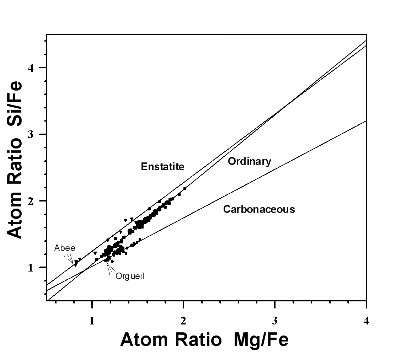 Only
five major elements [Fe, Mg, Si, O, and S] comprise at least 95% of the
mass of each chondrite and, by implication, each of the terrestrial
planets, and act as a buffer assemblage. Minor and trace elements are
slaves to that buffer system and are insufficiently abundant to alter
oxidation state. For decades, the abundances of major rock-forming
elements (Ei) in chondrites have been expressed in the
literature as ratios, usually relative to silicon (E
Only
five major elements [Fe, Mg, Si, O, and S] comprise at least 95% of the
mass of each chondrite and, by implication, each of the terrestrial
planets, and act as a buffer assemblage. Minor and trace elements are
slaves to that buffer system and are insufficiently abundant to alter
oxidation state. For decades, the abundances of major rock-forming
elements (Ei) in chondrites have been expressed in the
literature as ratios, usually relative to silicon (E